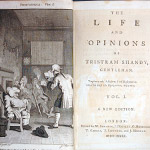 |
The jester-like Yorick stalks through the works of the Rev. Laurence Sterne (1713-68), appearing in his Sermons of Mr Yorick (1760), his A Sentimental Journey (1768) and in his masterpiece The Life and Opinions of Tristram Shandy (1759-1767). In fact, Yorick dies early in the first volume, yet reappears in various guises in this digressive, rollicking bawdy novel. James Boswell, a true representative of the times, wrote: 'Who has not Tristram Shandy read? / Is any mortal so ill bred?' Even though very popular, especially among twentieth-century writers such as Joyce, Proust, Beckett, and Kundera, one wonders how eighteenth-century readers came to grips with the structural inconsistencies, the allusions, the jokes, and the inconclusiveness of the plot. This edition includes the Hogarth illustration showing Corporal Trim reading a sermon. |

